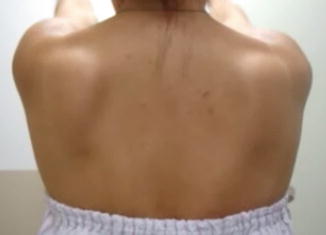Fig. 33.1
The two critical instances of potential injury during the throwing motion. (a) The moment of full arm cocking when the shoulder reaches maximal external rotation. During this moment, 67 N m of internal rotation torque and 310 N of anterior force are applied to the shoulder. (b) The moment of ball release as the shoulder begins to decelerate. Forces at this moment include 1,090 N of compressive force at the shoulder joint to prevent subluxation
As the initial symptoms are not visible to the eye, players often are unaware of these injuries and are able to pitch unhindered. But as the symptoms progress, the pitchers often express vague discomfort in the shoulder region while pitching and also has stiff shoulders that often feels like they are being “pinched.” They also feel that it becomes harder to warm up and have weaker joints, and with continued movements in this condition, the pitching speed eventually decreases and the pain becomes worse. Chronic pain can be seen to affect pitching ability negatively, and resulting from this, affected pitchers who attempt to use techniques from before the injury exhibit abnormal pitching motions. As a result, it overexerts the structure within the joints and damages the body severely.
Previous experiences, number of balls thrown in recent plays, and number of recent innings, they all play a part in identifying the fatigability of the player.
As the symptoms develop, patients can locate the source of the pain, but as the symptoms appear with normal pitching pain, it becomes difficult to differentiate the two through basic medical examinations. The action in which the chronic injury appears most frequently is the overhead arm motion, specifically the late cocking and the ball release stages. These positions are the positions that create the most stress for the shoulder joints.
33.1.3 Range of Motion
The most easily observed symptom resulting from the overhead arm motion is the limited motion of the shoulder joint. Most of the pitchers benefit from increased arm external rotations; however, at the same time, they suffer from decreased arm internal rotations. These characteristics are not exclusive to baseball pitchers, but also extend to other sports, such as tennis. This is due to the following reasons: First, the bone that is involved with the pitching of the ball becomes deformed from attempting to pull back the arm for long periods of time, which in turn limits the shoulder movement. Second, the anterior portion of the shoulder joint becomes loose while the back part contracts; by doing so this limits the shoulder joint movements (Fig. 33.2).
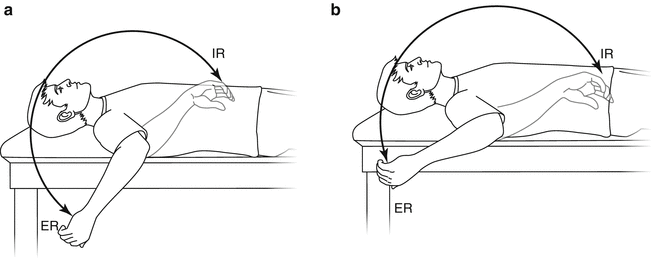

Fig. 33.2
The total motion concept. The dominant shoulder (a) of overhead-throwing athletes exhibits a greater external rotation (ER) and lesser internal rotation (IR) compared to the nondominant shoulder (b). However, the total motion (external and internal rotation) is equal bilaterally
However, research has shown that when the injured shoulder joint is compared with the other, uninjured shoulder, there is no difference in the total degrees of movement. As such, it can be observed that the contracted joint capsule does not have any effect in the case of the decrease in the internal rotation. Third, a theory exists that due to the unusual contraction of the posterior shoulder joint muscle, minor muscle damage occurs, while at the same time, range of motion seems to decrease. Finally, a theory exists that the range of motion for young baseball players is different to normal population due to adaptation of the physeal plate. The theories mentioned suggest that many other factors may be involved and the damaged range of motion in the shoulder joints can be repaired, and athletes should make a constant attempt to adjust their motion to a normal range.
33.1.4 Scapular Position
Scapula problems should be checked by sports players who often utilize their arm in a throwing or similar motion repetitively, such as pitchers or even archers. This can be done by standing in front and backward at the mirror to check the placement of the scapula and inspecting for twisted or asymmetrical placements. If this method is difficult to distinguish problems, weights of 1 or 2 kg can be used in each hand with vertical movements to confirm proper or improper scapular movements.
It has also been discovered that many players have suffered from asymmetric shoulder placement, causing lateral scapular displacement and the inferior border of the scapula to extrude away from the body while moving. This phenomenon occurs due to the lack of rehabilitation of the muscles which holds the scapula, and if movement is continued in this condition, it will cause pain in the anterior region of the shoulder and also in the cartilage inside the shoulder as it gets damaged. The photo below shows the 3D CT scan of a national archery player’s scapula (Fig. 33.3). This player pulls the bowstring using his right arm, causing the right scapula to be twisted. If the player continues to play the sport in this way, there is a possibility that it will lead to permanent damage, leading to decreased athletic performances.
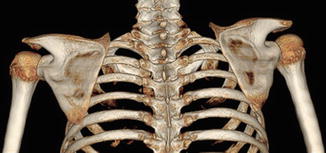

Fig. 33.3
Abnormal scapular position of right shoulder shown in 3D-CT scan
At this point, many players take months off to rehabilitate in order to strengthen the muscles and readjust the rising scapula to look like the photo below (Fig. 33.4). However, if no action is taken against this problem, there have been recorded cases of problems developing that cannot be helped with rehabilitation.
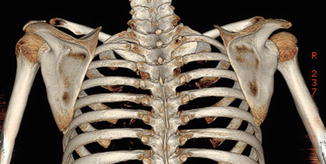

Fig. 33.4
Correction of scapular position of right shoulder after rehabilitation
33.1.5 Muscular Strength
Professional baseball pitchers who exercise every season for durations of up to 8 months have shown that there is a significant loss in muscle strength. This loss of strength persists even through shoulder joint conditioning programs designed to minimize muscular strength loss. The external rotation power of the arm reduces around 16 % during the mid-season and almost 21 % toward the end of the season. These issues do not make a huge difference to the shoulder muscles, but because of this, the fatigability of the muscle may increase. If these symptoms are continued, eventually the stability of the joint will decrease and there is a possibility that it could potentially lead to the development of subacromial impingement syndrome.
33.1.6 Proprioception
Overhead athletes have more relaxed joints and will be exposed to a wide variety of issues, leading to the shoulder joint to rely on proprioception. The proprioception ability will reduce when the player gets tired; however, it will return after a short break of 10 min.
33.2 Principles for Prevention of Injuries and Treatment Programs of Overhead Athletes
A general principle for the prevention of injury and curing of patients has been developed. Thus, it is important to have accurate basic knowledge on prevention and treatment program and also to practice clinically. The general injury prevention and treatment programs are as follows:
(i)
Maintain the range of motion.
(ii)
Maintain the shoulder muscle strength and endurance.
(iii)
Strengthen the neuromuscular control functions.
(iv)
Maintain the core and lower body muscles.
(v)
Practice and exercise during off-seasons.
(vi)
During the season, maintain muscle mass and muscle control.
33.2.1 Maintenance of ROM
The first principle includes maintaining proper pitching movement of the shoulder joint. Players who use overhead swinging motions generally have increased external rotation capacities, which allow for further movement to the back of the body, but suffer from limited movement in internal rotations, which limits the movement toward the front of the body. Even so, both arms still maintain the same range of motion. In other words, even if the injured arm has limited and increased movements in swinging back and forth, it will add up to an angle of 170, which when compared to the opposite arm which has a normal range of motion will be the same, as the other arm will also have a range of 170°. As this is just the body’s way of adapting to the continued use of the shoulder joint, it should not be a point of concern. Thus, after the season is over, the range of motion would be different from the initial range, so rehabilitation should be considered to equalize the range of motion, taking care to not excessively stretch the body to increase the range of motion.
If injuries are sustained or with incomplete rehabilitation, it is important to completely restore the range of motion. Rehabilitation times and methods vary among different types of injuries, but the most important thing to note is that attempting to return to using the same pitching motion without fully restoring the range of motion is very dangerous; therefore, trainers or doctors must prevent patients from throwing balls until they are fully recovered.
33.2.2 Maintaining Strength of the Shoulder Musculature
Repetitive throwing motion can cause damage to the shoulder joints, ligaments, and muscles, as it continuously applies pressure in those areas. Therefore, it is important to strengthen the muscle of the shoulder joint (which keeps the scapula in place within the body), elbow, and wrist. Perhaps you have seen athletes off the game using Thera-Bands or dumbbells to exercise while watching the game; this is one method to exercise during off days to improve the player’s playing ability.
Each player can check for the muscles that they need to exercise, but all players should not exclude the shoulder joint muscles, shoulder blade muscles, and the lower trapezius. These muscles are not the muscles to improve ball throwing but serve as protection to the athlete’s body while in throwing motion and also provide basic endurance.
Intrinsic muscles and extrinsic muscles originate from the scapula which makes the harmony during throwing motion. It is essential to keep up the harmony between the scapular and the humeral head to generate the high speed in throwing motion. And also the position of the scapula affects the glenoid labrum while pitching.
33.2.3 Emphasis on Neuromuscular Control
If you pitch with a lot of force, the joints and ligaments will get loose and will not move in a stable way and will be unstable during the pitching motion. When the joints move in an unstable fashion, damages can occur to the cartilage within the joint or tendons from the muscles. In order to prevent this, players must exert proper control over the muscle movements. Muscle control is an important factor in overhead motion injuries and treatment programs but is also one of the most important components in rehabilitation. With great control over the muscles, it is possible to prevent the forward movement of the shoulder during high-speed pitching and can prevent injuries of the shoulder muscles conflicting with nearby bones; therefore, muscle control is very important to overhead athletes who primarily utilize overhead arm motions.
Muscle control can be trained by rhythmic stabilization, reactive neuromuscular control drills, closed chain exercises, and plyometrics. If rehabilitation is done correctly, it is possible to develop balanced shoulder muscles, which prevents injuries during excessive throwing motion.
33.2.4 Core Muscle and Lower Body Training
The lower body makes up more than 50 % of the power while pitching. Core muscle exercises and lower body training not only allow the arm to move smoothly around the body, but also allow the shoulder to be in a stable state during pitching and are essential for the elbow and hand to pitch naturally. If the lower body muscle is weak and has a lack of endurance, or the muscle control is not great, the athletes cannot pitch in a normal fashion. As such the making of a good player is dependent on the strength of the lower body.
Core muscle training is an important factor in maintaining the exercise chain. It is also important for nonathletes on a weight-losing diet program, as it increases metabolism. But obviously, a good pitch will not happen if the lower body’s strength is not delivered into the arm. Suppose that core muscle is not strong enough. The strength from the legs will be stopped from the waist which means the strength should be reproduced beyond the upper body. Then, it is obvious that the speed or weight feeling during pitching will decrease.
Occasionally players who pitch while ignoring these facts will attempt to draw strength from the arm to maintain the speed of the ball, and unbalanced strength will be generated from the upper extremity. If this motion is continued, it could damage the arm and may result in deformation in pitching forms.
In conclusion, the leg and the body play an important role in the stability of pitching motions. Lack of body flexibility, the weakness of nondominant hip muscles, and decreased strength of hip abductors and spinal muscles can lead to destroyed exercise chain. This results in a spinal lordosis which leads to an abnormal posture (late forward movement of the shoulder joint compared to the lower extremities) at the acceleration of the throwing phase, and this is called “slow arm.” “Slow arm” can arise from excessive external rotation and abduction of the shoulder joint, which could possibly damage the glenoid labrum.
33.2.5 Off-Season Preparation
Also, the off-seasons are very good for the resting of the body, rehabilitation, and cure in preparation for the next season. Although they have a break in the beginning of the playoff season, they need to strengthen the muscles of the entire body step by step and work hard to regulate and maintain it. Although there are some public appearances during the break, it is still important to keep up the endurance and strengthen muscles sufficiently so that the player will not feel tired or weak during the season.
At the end of the season, even if the players do not play, physical rehabilitation should be continued. It is useful to maintain recreational activities such as swimming, golf, cycling, and jogging. This period before the next season can be seen as valuable time to rehabilitate the injuries previously sustained.
33.2.6 In-Season Maintenance
As much as off-season, it is also important to maintain muscle control, muscle strength, and endurance during the season. Repetitive exercises for such a long season can lead to decrease in performances of the player.
It is essential to take on a whole body muscle strengthening and regulating program and to look carefully at the shoulder joints and muscles. Shoulder or elbow joint fatigue or muscle weakness can lead to injuries as it makes the joints unstable; therefore, the muscle maintenance program during the season is an essential component.
33.2.7 Balanced Periscapular Muscle Exercise
The rehabilitation of the periscapular muscle is the most neglected aspect in overhead athletes. Many shoulder pain occurs from abnormal scapular movements and lack of rehabilitation. Scapular dyskinesis can also be divided into three subtypes:
Type 1 is anterior tilting of the scapula, resulting in protrusion of the inferomedial border of the scapula, and makes scapular retraction difficult during the cocking phase. It is related to the lack of flexibility in pectoralis major, pectoralis minor, and serratus anterior muscles (Fig. 33.5).
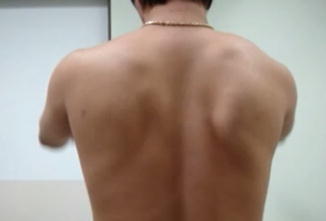
Fig. 33.5
Anterior tilt of right scapular (SD type I)
From the 3D CT scans, as shown on the left when compared to a normal person (right), the scapula is separated from the thoracic cage (Fig. 33.6).
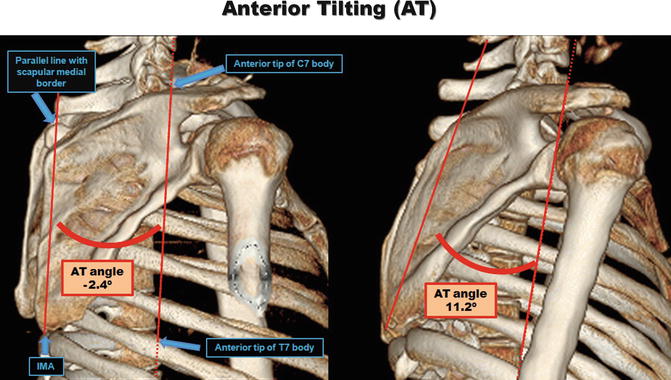
Fig. 33.6
Left picture: normal scapular position in 3D-CT scan. Right picture: anterior tilt of scapular in 3D-CT scan (SD type I)
Type 2 is protrusion of the medial border of the scapula due to an increase in internal rotation of the shoulder joint. It happens mostly from weakness in the upper, middle, and lower trapezius and rhomboid muscles. From the pictures below, the second type of scapular dyskinesis is visible on the right side (Fig. 33.7).

Fig. 33.7
Internal rotation of right scapular (SD type II)
With the use of 3D CT scans, it is visible on the right side where the scapula is rotating anteriorly to the thoracic cage compared to the normal left side of the scapula (Fig. 33.8).
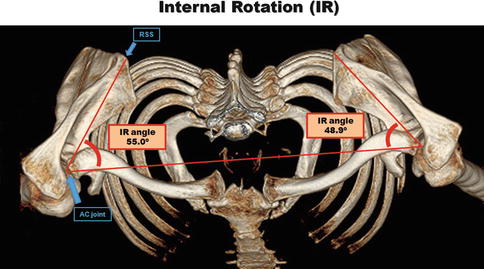
Fig. 33.8
Internal rotation of right scapular in 3D-CT scan (SD type II)
Type 3 is popping out (protrusion) of the superomedial angle of the scapula due to superior translation of the scapula. This phenomenon can easily be observed from your own body as you move your arm vertically while holding some weights. It is also known that the serratus anterior has been weakened in many players with type 3 scapular dyskinesis (Fig. 33.9).

